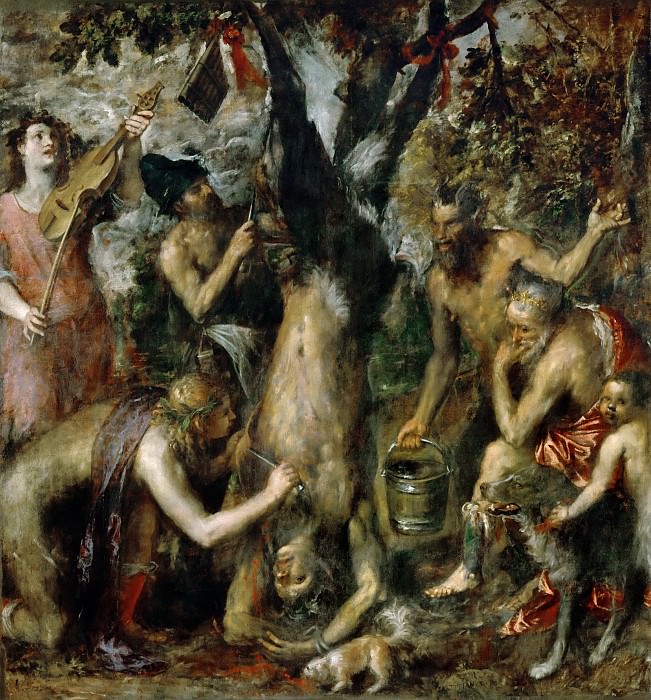Punishment of Marsyas Titian (Tiziano Vecellio) (1488/90-1576)
Titian – Punishment of Marsyas
Edit attribution
Download full size: 2835×3050 px (2,3 Mb)
Painter: Titian (Tiziano Vecellio)
Location: Archdiocesan Museum (Arcidiecézní muzeum), Kroměříž.
Titian Vechellio was a famous Italian painter who worked during the Renaissance. He is famous not only as a painter but also as a talented sculptor. A follower of Giovanni Bellini he created in the traditional style of the time - sketching from nature. Only with the advent of Giorgione appears his unique author’s style. The painting "The Punishment of Marcia" is done in a perfect technique of drawing, honed over many years.
Description of Titian Vechellio’s painting The Punishment of Marsius
Titian Vechellio was a famous Italian painter who worked during the Renaissance. He is famous not only as a painter but also as a talented sculptor. A follower of Giovanni Bellini he created in the traditional style of the time - sketching from nature. Only with the advent of Giorgione appears his unique author’s style.
The painting "The Punishment of Marcia" is done in a perfect technique of drawing, honed over many years. The artist continues the tradition of depicting myths and legends. It is based on the myth of Apollo and Marcia, who are engaged in a long argument: Which is better - the kifar or the flute? Whose craftsmanship is greater - the god or the satyr? Perhaps the artist wanted to show himself as his mind imagined him. One can see in the painting how Marsius, once proud and haughty, is sorry for what he has done.
The painting is done in only three colors, which betray with incredible accuracy the horror of the situation presented. The satyr was skinned for his arrogance. The executioner of Marcion is Apollo himself, who has stooped to the terrible cruelty of man - he sits squatting with a knife in his hand, having already sentenced him to punishment. At the same time, the eye is drawn to the figure sitting to the right of the main character - it resembles an artist who takes incomprehensible pleasure in the scene he is observing.
The appearance of dogs on the canvas is also not accidental: in most cultures, the dog is a friend of man and his faithful protector. Here, on the other hand, a heartless and proud dog is depicted sitting off to the side, while a second dog greedily clings to the martyr’s dripping blood.
There is not much emotion on Marcion’s own face: only his body language helps one realize what is going on in his inner world. His enemies, who torment him, sit all in the shadows, and only a glimmer of hope for forgiveness can be seen on the left side - the young man with the violin shows his submission to Apollo and pleases his ears with music in the hope that the god will forgive the satyr for what he has done. But you can see from his face that the punishment is repugnant to him. Raising his face upwards, the violinist seems as if he is withdrawing from what is happening so as not to observe the whole picture unfolding.
The canvas The Punishment of Marcion was painted as the artist’s last canvas. Titian chose to leave the message as a parable of pride and arrogance.
Кому понравилось
Пожалуйста, подождите
На эту операцию может потребоваться несколько секунд.
Информация появится в новом окне,
если открытие новых окон не запрещено в настройках вашего браузера.
You need to login
Для работы с коллекциями – пожалуйста, войдите в аккаунт (open in new window).




















COMMENTS: 1 Ответы
А народу-то, народу! Просто праздник какой-то: сдирают кожу!
You cannot comment Why?
The painting The Punishment of Marsyas depicts a gruesome scene from Greek mythology. In the center, Marsyas, a satyr, is tied to a tree and being flayed alive. His body is pale and contorted in agony. To the left, Apollo, the god of music and arts, is depicted with a serene expression, holding a violin, indicating his victory in a musical contest against Marsyas. Surrounding the central figures are satyrs and nymphs, some actively participating in the flaying, while others observe the horrific event with a mix of emotions, from indifference to fascination. One figure, possibly a judge of the contest, sits thoughtfully, observing the punishment. The scene is set in a wild, wooded area, with lush foliage and dappled light creating a dramatic and unsettling atmosphere.
The subtext of the painting can be interpreted in several ways: